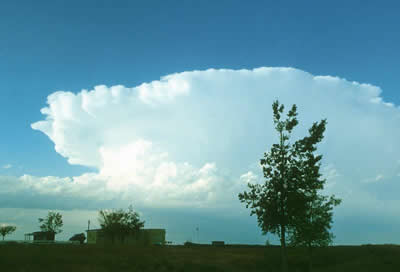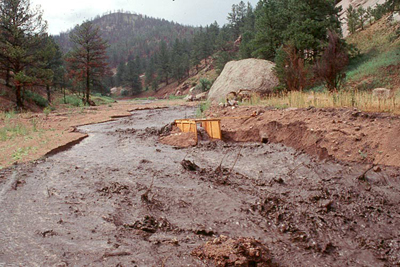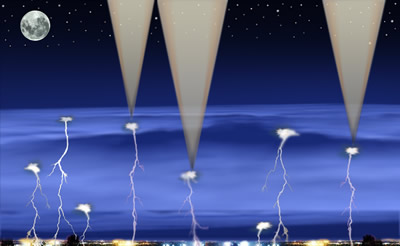This cumulonimbus cloud has the characteristic anvil-shaped top.
Click on image for full size
Courtesy of UCAR Digital Image Library
Thunderstorms
Thunderstorms are one of the most thrilling and dangerous types of weather phenomena. Over 40,000 thunderstorms occur throughout the world each day.
Thunderstorms form when very warm, moist air rises into cold air. As this humid air rises, water vapor condenses, forming huge cumulonimbus clouds.
There are two main types of thunderstorms: ordinary and severe. Ordinary thunderstorms are the common summer storm and usually last about one hour. The precipitation associated with these storms includes rain and occasionally small hail. With ordinary thunderstorms, cumulonimbus clouds can grow up to 12 kilometers high.
Severe thunderstorms are very dangerous. They are capable of producing baseball-sized hail, strong winds, intense rain, flash floods, and tornadoes. Severe thunderstorms can last several hours and can grow 18 kilometers high. Several phenomena are associated with severe thunderstorms, including gust fronts, microbursts, supercell thunderstorms, and the squall lines.
You might also be interested in:

Condensation is the process by which water changes its state from a vapor or gas to a liquid. Condensation is responsible for the formation of clouds. Common examples of condensation are: dew forming on
...more
Cumulonimbus clouds belong to the Clouds with Vertical Growth group. They are generally known as thunderstorm clouds. A cumulonimbus cloud can grow up to 10km high. At this height, high winds will flatten
...more
Rain is precipitation that falls to the Earth in drops of 5mm or more in diameter according to the US National Weather Service. Virga is rain that evaporates before reaching the ground. Raindrops form
...more
A supercell thunderstorm is a huge rotating thunderstorm. It can last for several hours as a single storm. These storms are the most likely to produce long-lasting tornadoes and baseball-sized hail. Tornadoes
...more
Wind is moving air. Warm air rises, and cool air comes in to take its place. This movement creates different pressures in the atmosphere which creates the winds around the globe. Since the Earth spins,
...more
Dangerous flash floods have killed hundreds of people and caused hundreds of millions of dollars of damage in the Front Range of Colorado’s Rocky Mountains. The area gets summer flash floods when intense
...more
Scientists and students have designed a new satellite called Firefly for the CubeSat program. The Firefly satellite is the size of a loaf of bread and consists of three cubes attached end to end in a rectangular
...more














